Big sky, scorched earth at Big Bend National Park (Day 1)
Lured west by the mystery of one of America’s lesser known national parks, we packed broad-brimmed hats, sunscreen, and several gallons of water in the trunk and left behind the crowds of SXSW last Wednesday, driving for 8 hours through increasingly open country to Big Bend. Traveling to Big Bend brings home just how big Texas is, and how varied the topography. It’s not an easy park to get to. Nearly 6 hours by car from the nearest city, El Paso (or 10-1/2 hours from Houston on the other side of the state!), Big Bend is tucked in a broad crook of the Rio Grande, the river that separates the U.S. from Mexico, in remote west Texas. From Austin you drive through the rolling, green Hill Country until it gives way to the flat, brown tableland around Ft. Stockton, and when you reach Alpine or better known Marfa you head south into the stony, mountain-rimmed Chihuahuan Desert.
Unlike so many before me, I did not fall in love with the desert. The unprotected openness, forbidding landscape, and glaring sunlight felt oppressive to me. I was awed by the vistas and hiked some of the trails, but I felt no love for the place. Until the evening, that is. Each evening as the sun dropped to the tops of the jagged hills, bathing the sun-baked landscape in a rosy glow, bright stars emerged in the vast sky, a cool breeze picked up, and I breathed a sigh of relief and appreciation. These images were taken just inside the park on our first such evening.
As you can see, the extreme drought in Texas has left its mark on Big Bend as well. Even desert plants must have water, and west Texas has not seen the recent rains that have greened up central Texas. I’d hoped to see wildflowers dotting the desert floor, but almost the only plant in bloom was the distinctive ocotillo (Fouquieria splendens), a vase-shaped collection of tall, spiny branches which are usually leafless and able to photosynthesize quite nicely without them.
After a rain they will leaf out briefly, and we did see some in full leaf on our visit, but in dry springs like this one they are able to bloom without leafing.
Ocotillo and the ubiquitous creosotebush (Larrea tridentata), two of the hardiest plants in the desert
Creosotebush fascinated me with its cheery, yellow blossoms and black-and-white striped bark.
Beautiful bare branches
Alas, not all of Big Bend’s flora has fared so well during the drought.
Everywhere plant corpses littered the ground like animal bones.
Even lechuguilla (Agave lechuguilla), found naturally only in the Chihuahuan Desert, could not cope with the utter lack of rain. Entire hillsides of this plant were bleached and dead.
It was sad to see so much loss, even in this stark, unfamiliar region. But there was beauty too, especially in the sunsets.
I’ll have more pictures from Big Bend soon with a post about the Chisos Basin, Santa Elena Canyon, and other sights. Stay tuned.

By the way, my blog Digging is a finalist for Best Gardening Blog in the Readers’ Choice Awards at About.com. I’d love to have your vote. You can vote once a day (it’s on a 24-hour cycle) until March 21. So vote early and often! Thanks for your support! (And thank you to Pamela Price for the vote graphic.) Click to VOTE.
All material © 2006-2012 by Pam Penick for Digging. Unauthorized reproduction prohibited.


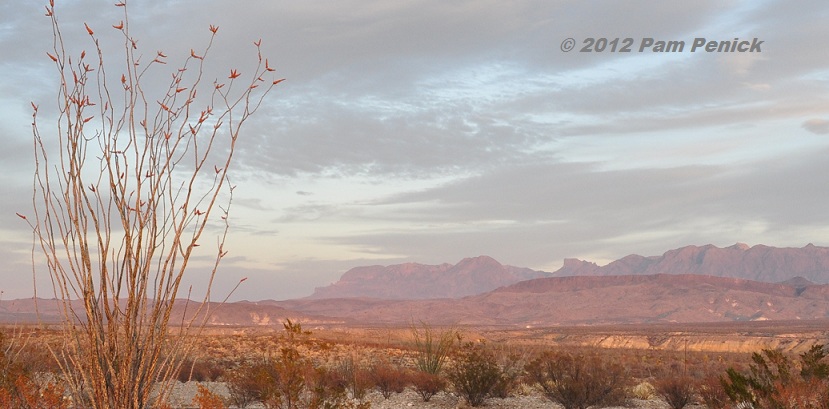
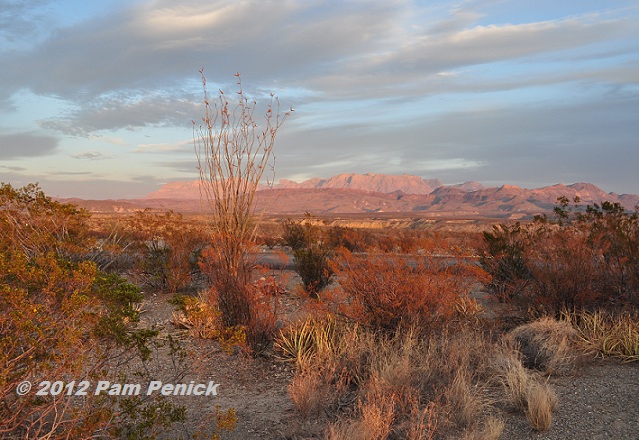
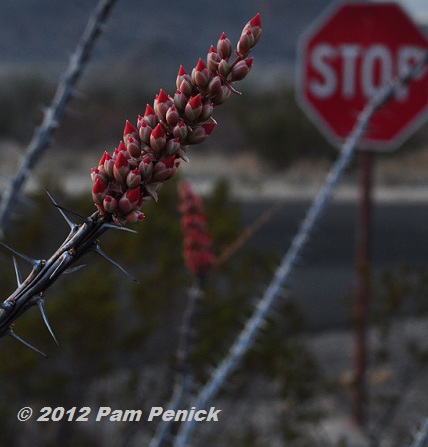
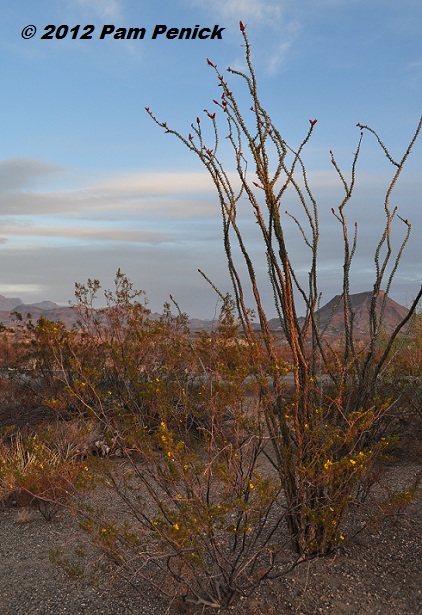
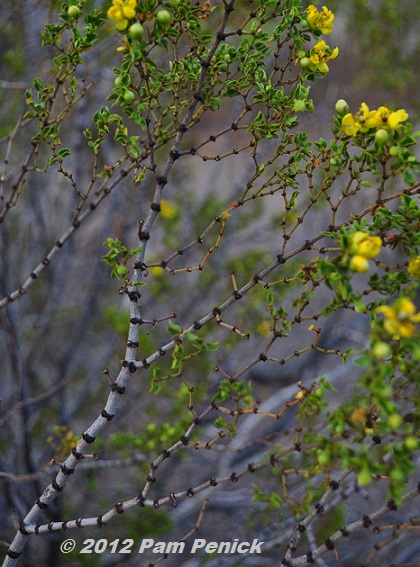
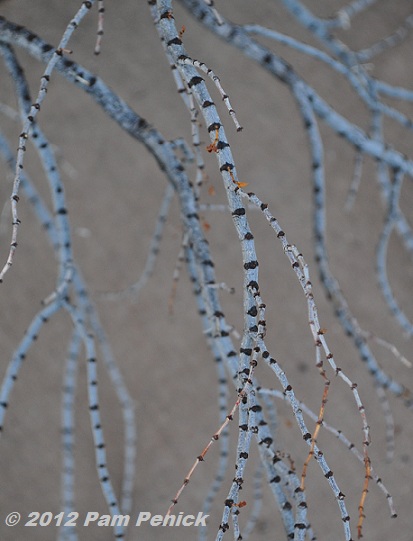
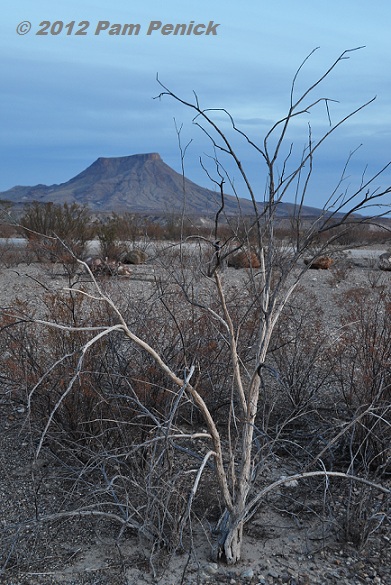
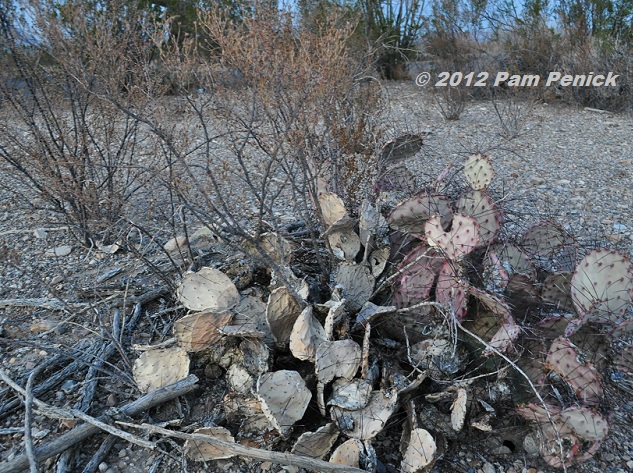
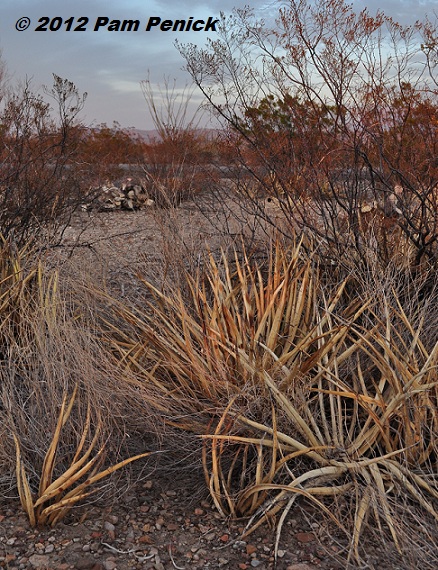
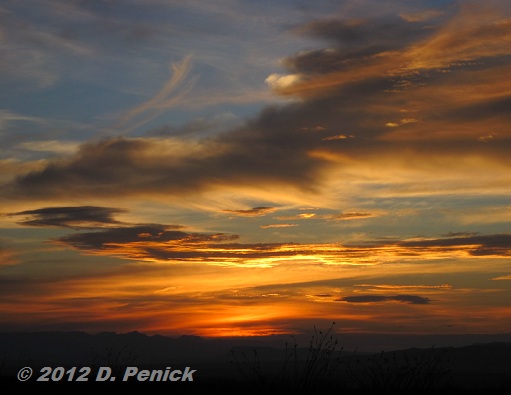
Breath-taking photos Pam, and you even captured the sad beauty in the dead Agave lechuguilla. Your description of the desert “the unprotected openness, forbidding landscape, and glaring sunlight” seems spot on and even sitting here in tree covered, grey and very wet Portland I could feel the oppression, a much different sort than I am currently enduring.
Loree, you would have mourned all the dead agave, yucca, and Opuntia. Still, we saw plenty of living “danger plants,” and I’ll have more pictures in upcoming posts. But I tell you, central Texas never looked so green and tree-covered to me as on our return from the desert. —Pam
The first photos call my heart back to Big Bend…the last make me want to cry. So sad to see how the drought has caused so much damage. What about wildlife? Did you get any insight as to how the wildlife has handled the drought? Look forward to hearing more.
Cat, it was heartbreaking indeed. It recalled a bit of the drought-despair I went through last summer in Austin, before things greened up again with the rains. We were disappointed to see hardly any wildlife, even though we took morning and evening drives and walks. But I understand the desert animals are elusive even in the best of times. We did see a couple of Carmen deer in the Chisos Basin, some wild burros, one rabbit, and birds. No javelinas, scorpions, snakes, bears, or mountain lions! —Pam
I haven’t been to Big Bend, since I was 12. That’s been a couple years. 🙂
But, I do remember the vastness of it.
There was a big wildfire out there last spring. That could be another reason for the loss of so many plants. Let’s hope the desert returns to normal soon.
Great photos, as usual.
Thanks, Linda. Yes, I hope the desert gets some rain soon. —Pam
I’ve never once seen ocotillo in bloom or leaf, no matter how many times I’ve been down that way. You lucked out. Sorry to see you didn’t get any wildflowers. When we were in the area in December we saw lots of scorched earth from last year’s wildfires so it was hard to tell what it might look like in spring. I’m not sure about the Big Bend area, but I was told that August is a good time to look for wildflowers in the Davis Mountains because June and July is when they will typically get rains (fingers crossed of course).
I do feel lucky to have seen the ocotillo in bloom. It’s such a striking plant, in bloom or not, in leaf or not. Mexicans were offering little beaded representations of ocotillo to tourists. I almost bought one, but it would have meant breaking the law since casual trade across the border is illegal, as signs reminded us all along the Rio Grande. —Pam
We have visited Big Bend twice, always in April, when cactus and ocotillos were in bloom, so it is sad to see the damage done by the drought. Unlike ourselves, it is hard to imagine that they will be having a spring flower show. However, I have to say I love the desert landscape. It seems strange to say that knowing the place I grew up and my method of gardening today which matches my heritage much better. I have this great desire to have a garden which is more sparsely planted but somehow I just can’t do it. I have to go to the desert to enjoy it.
I think your garden is a perfect combination of English style and rugged Southwestern style, Jenny. Don’t change a thing. 🙂 —Pam
Drought and fire. Here’s wishing for timely rain so the seed banks can start the next generation and the wildlife can pull thru.
Yes, I hope for that too, EE. Thanks for commenting. —Pam
Thanks for sharing these beautiful vistas. I have never been to Big Bend, can you imagine traveling that terrain in a covered wagon?
No, I really cannot. Whew, those pioneers were a tough lot. —Pam
Wonderful photos!
Thanks, Phillip. I’m glad to know you were able to leave a comment on my WordPress blog. I wonder why we’re having trouble on other WP blogs. —Pam
Tragically beautiful. Big Bend is the park I most want to visit.
While not exactly close, it’s the closest national park to Austin (well, it’s tied with Hot Springs National Park in Arkansas). Maybe you’ll be able to get out there soon, AR. —Pam
Hi Pam, I came here from FB to see if I could leave a comment. Wow, what awesome images of a place I am glad to have visited from the comfort of home.
Thanks for trying your comment, Sue. I’m glad to know you were able to do so, and I’m also happy you enjoyed the pics. —Pam
I have been to this park and general area. I remember the colorful lizards that were about at the time we were there. I bet they haven’t fared well during this drought either.
I wonder. We did see a couple of lizards, though not the colorful ones we’d read about. —Pam
The Texas branch of the family went camping and rafting in Big Bend last year and said it was all magnificent. They had a great time. The rafting gave them some real thrills!
I bet rafting was a lot of fun. We saw plenty of outfitters for rafting and canoe trips on the Rio Grande. —Pam
Great pics, especially of my favorite plant, Creosote Bush. The one with the bare stems is amazing in the detail you caught, the dark areas that were once twigs…mmmm! Drought, yes, I see those pics and that is what Abq is like…this year might be the one that hits us, since we’ve skated on severe heat and drought since 2003. And you got the character of it right, so right. Your change in perspective to your own home is also great for you…seeing ATX from the desert is good, just like me seeing the desert from your place is good! Great trip…more:-)
(I’m also unable to leave comments on a few WordPress blogs, but most are still fine, like yours)
Thanks for your comment, David. You are so right that we bring different perspectives to places based on where we’re from. I remember reading a quote by Scott Calhoun (I think) that when he was traveling east, away from his Arizona desert home, he marveled over the squishiness of the earth and didn’t like it. He was used to the sun-baked, hard earth of his home, of course, and so that’s what it should be like. 🙂 —Pam
It’s not the desert so much that gets you but the time of day. Exploring the lower desert (Big Bend wise) is best done early morning. One of the places to go is Dagger Flats to see where Yucca rostrata and Yucca faxoniana grow. Along the way you see many cacti, rocks etc… You even see some of the small native trees like Texas persimmon and golden ball lead tree. There is a lot of plant diversity and that’s just the desert alone. Looking forward to the Chisos!
We didn’t make it to Dagger Flats on this trip, David R, and now I’m sorry we didn’t. The Chisos post is up! —Pam
Love those first two photos! I’m headed there in a couple of weeks. Your photos make me long for “the magic hour” near sunset at Big Bend.
That’s the time of day I really enjoyed Big Bend, Caroline. Sunset is magical indeed. Enjoy your visit! —Pam
B-E-A-U-TIFUL pictures!!! I love Big Bend, my husband and I were actually talking just the other day about taking the kids there to camp. I went there loooong ago with my family too and just want to go back. Thank you for sharing! love your site and found you on Austin Blogs’ FB page 🙂
Thanks for visiting, Ashly! I hope you get to go back to Big Bend with your family soon. —Pam